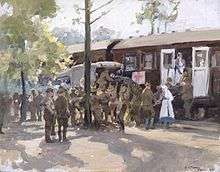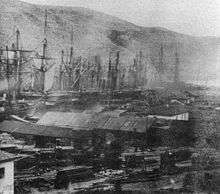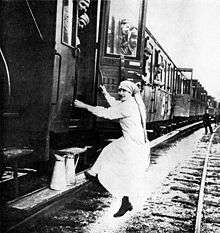Hospital train

A hospital train is a railway train with carriages equipped for the provision of healthcare. Historically this has ranged from trains equipped to transport wounded soldiers, with basic nursing and first aid facilities on board, to fully equipped mobile medical centres, sometimes including operating theatres and nursing wards.
History
Origins

Photograph by Roger Fenton.
The first hospital train was built during the Crimean War in the 1850s. Poorly operated logistical supply networks and inadequate health provisions for the British army encamped around the Russian port of Sevastopol caused a public outcry in England. To alleviate these problems, the Grand Crimean Central Railway was initially built by a partnership of English railway contractors led by Samuel Morton Petoin 1855, to supply ammunition and provisions to Allied soldiers. Within three weeks of the arrival of the fleet carrying materials and men the railway had started to run and in seven weeks 7 miles (11 km) of track had been completed. The railway was a major factor leading to the success of the siege. The line was surveyed by Donald Campbell.[1]
Although the railway's primary function was the supply of armaments and equipment, the train was also used for the transport of the wounded. The first such instance of this occurred on April 2, 1855, when the train was used to carry the sick and injured from the plateau down to the dock at Balaclava.[1] Towards and during the second winter, the supplies carried by the railway were different. The siege had ended, carriage of ammunition was less important, and the supplies related more to the accommodation and comfort of the troops. These included huts to replace tents, clothing, food, books and medical supplies. Following the completion of the Sardinian branch, the railway had reached its limit. In all, it measured about 14 miles (23 km) plus a few miles of sidings and loops.[1]
Expansion


Hospital trains were subsequently used during the Franco-Austrian War, the American Civil War and the Franco-Prussian War. They were also used extensively during colonial campaigns, notably in the Anglo-Zulu War.[2] However, these hospital trains remained primarily as troop trains, with the passengers restricted to the wounded and dying. They had little or nothing in terms of onboard medical facilities, although nurses traveled with the wounded and the carriages of the trains were painted with red crosses to indicate their humanitarian role and to prevent enemy attack.
It was during the First World War that trains began to be used as mobile medical facilities along the Western Front and other subsidiary theatres of the War. Ambulance trains were organised by the Royal Army Medical Corps with onboard surgical wards and essential medical supplies. Trains were used to evacuate over 100,000 British casualties from the battlefield at Flanders in one month of 1914 alone.[2]
These trains were able to connect with hospital ships at French channel ports in order to repatriate wounded British soldiers back to England. There are numbers of extant journal entries from those who experienced the hospital trains of this era, many being referred to as "Great White Hospital Trains", as the carriages were often painted white or red and white.[3]
Hospital trains were used on a large scale during the Second World War by all the major combatants and, to a more limited extent, during the Korean War. By that time, however, mobile motor transport and aerial evacuation supplanted the train as the dominant form of mobile medical provision on the battlefield.
Currently operating hospital trains
The Sovereign Military Order of Malta
The Sovereign Military Order of Malta (SMOM), which is a sovereign entity (similar to an independent country, though with virtually no land), has a history of operating hospital trains through its military branch, known as the Military Corps of the Order. The operation of such trains reached its peak in the Second World War, but SMOM continues to operate such trains today.[4] These include trains of carriages to provide shelter to refugees, with basic medical provision, and more technically equipped trains, on which a wide range of medical services may be provided.
Lifeline Express of India
The Lifeline Express is an example of a modern hospital train of a highly technologically advanced type. Operated by the Impact India Foundation since 1991, these trains have had a profound impact on Indian rural healthcare provision.[5]
Operating in India, across the extensive network of the Indian Railways, the Lifeline trains (known colloquially as 'magic trains') move from town to town, remaining in a siding or platform at each town's railway station for perhaps a week or so, and providing advanced medical services (often beyond the capabilities of local medical centres) to those who apply for them, through a simple vetting or triage process, which ensures services are provided to those most likely to benefit. These trains include nursing wards, and full-scale operating theatres. They have resident medical and nursing staff, but for surgical procedures they rely upon the charitable provision of time and talents by Indian surgeons who spend some of their free time on board the trains for that purpose.
Chinese eye hospital trains
The state-owned China Railways company currently operates four eye hospital trains, the fourth and latest being operated through the China South Locomotive and Rolling Stock Industry (Group) Corporation, and having entered service in early 2009 for the benefit of residents of the Sichuan Province. A range of ophthalmic surgeries, including the common cataract removal operation, can be provided free of charge on board the trains.[6]
Gallery
 Hospital train cars parked on the grounds of the VIIIth Mobilization Center of Italian Red Cross, near Marina di Massa, Tuscany
Hospital train cars parked on the grounds of the VIIIth Mobilization Center of Italian Red Cross, near Marina di Massa, Tuscany- Terapevt Matvey Mudrov, a train-based mobile medical center of Russian Railways
 A hospital train car in Russia's National WWII Museum
A hospital train car in Russia's National WWII Museum United States Army Medical Kitchen car at the United States Army Medical Department Museum
United States Army Medical Kitchen car at the United States Army Medical Department Museum
See also
References
| Wikimedia Commons has media related to Ambulance trains. |
- 1 2 3 Cooke, Brian (1990), The Grand Crimean Central Railway, Knutsford: Cavalier House, pp. 16–30, ISBN 0-9515889-0-7
- 1 2 Jack Edward McCallum (2008). Military Medicine: From Ancient Times to the 21st Century. ABC-CLIO. pp. 154–155.
- ↑ See here for one example of an extensive journal entry from the first world war hospital trains in Europe.
- ↑ Ordine di Malta - Sito Ufficiale - Archivio Fotografico (in Italian)
- ↑ See the Impact India website here.
- ↑ "CSR rolls out eye hospital train". Railway Gazette International. 18 March 2009.